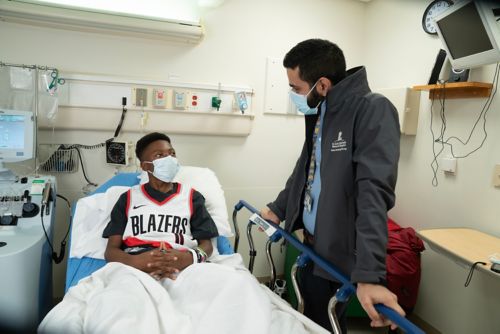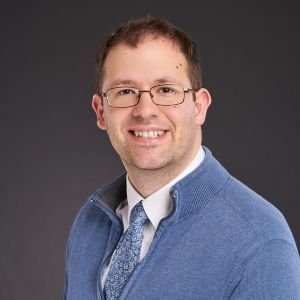St. Jude Family of Websites
Explore our cutting edge research, world-class patient care, career opportunities and more.
St. Jude Children's Research Hospital Home

- Fundraising
St. Jude Family of Websites
Explore our cutting edge research, world-class patient care, career opportunities and more.
St. Jude Children's Research Hospital Home

- Fundraising
Boot camp trains sickle cell disease ‘pain crises champions’ to improve patient care

(L to R) Rashawn Hendrix, a St. Jude patient with sickle cell disease, talking with his physician, Tarun Aurora, MD, a former St. Jude clinical fellow.
Before he was a patient at St. Jude, Rashawn Hendrix experienced something far too common among patients with sickle cell disease: pain not taken seriously. “At the hospitals I used to go to, it’s like they would think I’m not really sick,” said Hendrix, who has experienced regular sickle cell pain crises. “I would get a longer wait time when I was sick. Even though I was there earlier, others would go through [the emergency room] before me.”
“It seems like [doctors and nurses] didn’t take me seriously when I was having pain,” Rashawn continued. “I always felt left out because they were treating other people better than me.”
Sickle cell disease can outwardly appear invisible to emergency medical staff. A bleeding wound is an obvious threat where blood loss can lead to loss of oxygenation to tissues. A patient with sickle cell disease experiencing a pain crisis could be experiencing the same lack of tissue oxygenation, except it isn’t outwardly visible. The crisis can be just as acute but is more often overlooked.
“It’s very frustrating,” said Tara, Hendrix’s mother. “The doctors tell him he’s not in as much pain as he’s saying he is, and I get angry because why would he fake his pain? There’s a lot of people who don’t understand sickle cell.”
While the situation has changed for Hendrix since he came to St. Jude, there remains a significant need in the overall medical community to address the lack of clinical training in proper care for patients with sickle cell disease. To help, St. Jude, The International Association of Sickle Cell Nurses and Professional Associates, and the University of Tennessee Health Science Center (UTHSC) have teamed up to host Sickle Cell Nursing Boot Camps.
Sickle cell disease nursing boot camp

Yvonne Carroll, JD, RN, St. Jude Hematology Program director
“The boot camp is for nurses and nurse practitioners who care for people with sickle cell disease,” said Yvonne Carroll, JD, RN, St. Jude Hematology Program director. Carroll and Sara Day, PhD, RN, FAAN, Professor and Assistant Dean of the UTHSC Center for Community and Global Partnerships, founded the boot camp. A USDA grant of $390,000 currently funds the boot camp; grant investigators include Day, Carroll and Keesha Roach, PhD, Assistant Professor at UTHSC.
“In nursing school, there is no standardized, evidence-based training for nurses in sickle cell disease,” Carroll explained. “This is a one-of-a-kind educational opportunity to fill in this well-known gap in care.”
The nursing boot camp for sickle cell disease is a five-day intensive and interactive experience. Nurses have come from across the country — and now the world — to participate in the first several camps. The first day begins with the most important focus of the boot camp: patients and families like Hendrix and his mother. These patients volunteer to voice their experiences and needs. Throughout the week, the nurses receive a mix of educational lectures, practical demonstrations and time to network with each other.
“The fifth and final day is when the attendees do their teach-backs,” said Day, who has been involved in nursing education for decades. “They are assigned a subject and teach it back to the group, which allows them to process the information. People don’t learn by listening; they learn by processing, talking and doing. Combined with some activities where we teach clinical skills, we provide a comprehensive overview of how to provide quality care for persons with sickle cell disease.”
Caring for sickle cell and pain crises
Unfortunately, Hendrix’s experience of being overlooked in emergency rooms and hospitals is common. Pain crises are a major symptom of sickle cell disease, but few are trained on how to deal with them. The lack of understanding is partially due to the complicated nature of sickle cell disease, which is taught at the boot camp.
In sickle cell disease, the oxygen-carrying molecule hemoglobin becomes too stiff. This, in turn, forces red blood cells into the trademark sickle shape. The stiff shape cannot move through the smallest blood vessels, clogging these capillaries. Organs are some of the most oxygenated tissues, often having many capillaries. Therefore, patients with sickle cell disease experience damage to every organ. The pain they feel is from the same source: the sickled cells cause blockages in blood vessels in the chest, abdomen, thighs, or other areas, resulting in intense pain. Many patients find it difficult to procure pain relief medication to resolve the issue, as scrutiny for requesting opioids has increased.

Sara Day, PhD, RN, FAAN, Professor and Assistant Dean of the UTHSC Center for Community and Global Partnerships
“There is strong stigma against these patients, as they are seen as just seeking pain medicine, which is not true,” Day said. “Persons with sickle cell disease do not have an increased incidence of opioid dependency than other persons with chronic pain. Their pain crises are very real and based on the pathophysiology of the disease. They need access to timely and appropriate pain management.”
Outside of direct pain management, the course also teaches about hydroxyurea which can lessen the underlying cause of pain and is the most commonly available treatment for sickle cell disease. The drug was first tested in 1984 and is the mainstay treatment to help prevent painful episodes in people with sickle cell disease. However, even with a 40-year history, hydroxyurea is still under-prescribed and utilized by health care professionals.
“We have hydroxyurea, which can actually prevent sickling,” Day explained. “It’s really a miraculous drug, but you have to know how to prescribe it, as it must be titrated and monitored properly.”
In addition to standard care, the multi-organ nature of sickle cell requires a large amount of knowledge to recognize true emergencies. Carroll gave a very real example of how a nurse’s understanding of the disease could prevent a situation from deteriorating.
“What does it mean when the hemoglobin level is really low in a patient with sickle cell?” she asked. Patients with sickle cell disease often have a lower hemoglobin level than the average person, something that can cause so many false alarms that a precipitous drop in hemoglobin — a true emergency — may be missed.
“If you don’t understand when an alert is real versus when this is a patient’s normal hemoglobin level, then you’ll possibly make the wrong call,” Carroll continued. “This could be an emergency. If you don’t make the right call, by the time someone comes around, say, the next morning, when the doctors come in, it may be a critical situation.”
The boot camp is designed to give nurses a fundamental understanding of the disease so they can make educated decisions in the moment. Bringing this expertise to nurses on the frontline, in decision-making positions, and in academia is key to raising awareness and improving care for people with sickle cell disease.
Getting sickle cell expertise where it is needed
Geography has a major impact on access to quality health care. It is particularly harsh on those living without local access to health care. That fact remains true even in fully industrialized countries, such as the United States.
“Many rural areas lack health care providers that are knowledgeable about sickle cell disease because they don’t see it often,” Carroll said. “That’s one of our goals. We’re giving as much education as possible in hopes that it will spread to these places.”
The boot camp’s model is a train-the-trainers approach. Nurses participating in the weeklong course are then expected to return to their home institution to teach their colleagues the information they’ve learned. The hope is that they will then also work with other local institutions and train them, spreading the information where it is needed. Over 100 nurses have attended the boot camp in Memphis, with approximately 25% from St. Jude or St. Jude partners or affiliates, including St. Jude international collaborators in Brazil, Costa Rica, Tanzania and Nigeria.
“It’s been very rewarding for me because the attending nurses have already implemented solutions,” Day said. “They’ve done newsletters and educational training and added sickle cell to orientations. Everyone has done something and is in the process of going back home to be the expert that can share knowledge and teach other people.”
A greater impact than sickle cell
The boot camp has real potential to set better standards for sickle cell nursing care. At the end of the day, improving the lives of patients with sickle disease is the most important outcome. For that, Hendrix had his own advice.
“They should smile, and show they care,” he said. “Talk to us, listen to us. My doctor [at St. Jude], Dr. Aurora, made me really feel that he has a lot of love and respect for me. They should be training people for that.”
Nurses interested in learning more about caring for patients with sickle cell disease should apply to next fall’s boot camp.






